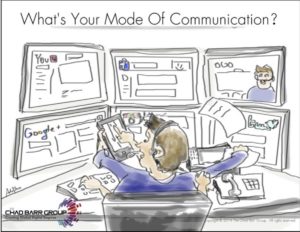Communication Woes – Feeling Overwhelmed
A History of Communication
A long time ago, people used smoke signals to communicate. Later, with the development of paper, pencils and pens, written letters became the main mode of sending information. The written letter slowly lost popularity with the introduction of the telephone. And back then people generally answered the telephone if they were home, even when they didn’t know who was calling. At my home growing up, all the members of the house would answer the phone, “Roberts Residence. May I help you?” If someone called and you were not home, then no one would answer, that is, until the introduction of the answering machine. It even took some of us a while to discover that a blinking light meant that there was a message!
Some years later, call waiting was invented and you could be interrupted while on a phone call, but yet you still had no idea who was calling. With a little more innovation, Caller ID was introduced and one could now know who was calling. With technological advancements came voicemail, fax, and e-mail and one now had plenty of options to choose from when deciding on how to communicate with someone. You could write someone a letter, call them, leave a message or even fax or email them.
Communication in the Modern World
In our modern world, we have text messaging. This seems to be most popular method of communication, especially among the younger generation. Now my son, Craig, rarely answers his cellphone when someone calls him and he seems to never listen to his voicemails. If I need to reach him, I need to text message him. Then, and only then, do I get a reply. My other son, Brad, says he does read his text messages, but by the time he checks them he usually has 10 or more unanswered text messages. He is typically busy, running to meetings and such, and then forgets that he never replied to his mother. I said we ought to invent an app to remind people that they have not replied to a text message, so they can reply later!
In an attempt to keep up with everyone who tries to reach me, I have an answering service that handles my calls. They provide messages that callers would like to leave for me, and I am able check and respond to the messages when it is convenient. Despite having this service available, people will often choose to leave an instant message for me on Facetime, even when I clearly ask people to leave messages with my answering service. Because of all of this, I am forced to check my voicemail, email, text messages, answering service, and instant messages continually throughout the day, or risk missing an important message.
How Others Recommend Dealing with this Communication Crisis
I was recently reminded of these communication challenges when looking through my weekly newsletter from Chad Barr (CBSoftware). In this newsletter, he focused on the same topics that I am discussing now, and I laughed when he wrote about his own son not answering the phone.
He wrote: “I’ve come to realize that my son rarely answers when called on his mobile phone but always replies to texts. Similarly, I’ve observed that some of my clients prefer to communicate via phone, some primarily by email, others, when possible, in person, or via text, some via the social media platforms, and many via Zoom, Google hangouts and the like. It’s obvious that individuals have many different partialities as to the way they like to communicate.
Therefore, I recommend that you embrace and enable as many modes of communication available to you that fit the preferences of your target audience.”
I do agree with Chad, however, on a busy day with so many different modes of communication and trying to remember other people’s preferred method of communication – I don’t know about you, but I am feeling overwhelmed!
The Solution
I have some advice for dealing with this myself. I try limits and boundaries. I ask everyone to use my preferred method of communication, which is to leave a brief message with my answering service. I also tell my patients that those messages such as, “going to be late” can be sent to me via text message, but something more in-depth, such as dreams or insight should be sent to me via email. I still like getting handwritten cards, but these seem to be a thing of the past. As for instant messaging, I do not usually respond unless I know the sender personally, except for when it is on my business Facebook page. Bottom line for me….I like to talk in person, on the phone or via Zoom. However, in a world with so many different communication methods, I realize in order to stay in touch, reach, and help as many people as possible, I need to embrace all of the modern ways in which we can now communicate with one another. There is a Way™!
Dr. Diane©



